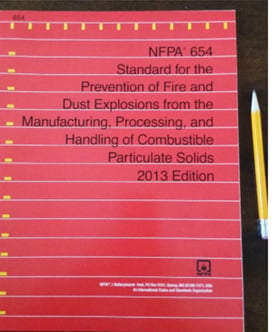One of the issues when figuring out if your dust is explosive is the particle size of the dust and the location where you are assessing the dust. Material that consists of very large particles sizes (larger than 500 micron) tend not to be explosive. While larger particles can catch fire, they tend to prevent explosions. However, this might not be as straight forward as you think.
Is the Process Explosive?
Let’s assume that you have a conveyor belt that feeds a grinder which then empties onto another conveyor belt which feeds a bagging station. Let’s assume that the material starts out with a particle size distribution of 10% less than 500 micron and 90% greater than 500 micron of a combustible material. After it is fed into the grinder, its target size is around 200 microns. The question is, is this process explosive? Your 1st thought would be that before the grinder, the dust is too large to be explosive, and you might want to take the material leaving the grinder and have it tested. So you test the material leaving the grinder on the conveyor and find out it isn’t explosive. Therefore you assume the whole process isn’t explosive. However, this might give you a false reading.
Is the Dust Cloud Explosive?
For example, the material falling on the conveyor belt that feeds the grinder creates a dust cloud. That dust cloud is made up of the finer particles, so it is probably made up mostly of the 10% that’s less than 500 micron. And this material could be explosive. Not only that, but if that 10% of the material particle size distribution has a significant amount of dust less than 100 micron, this could very well be the dust cloud which is much more likely to be explosive. And since the smaller the particle size the better the chance of the material being explosive, your dust cloud could be explosive dust. This would then float in the building and layer the surrounding equipment or rafters with explosive dust.
Now looking at the material leaving the grinder, even though it tested as not explosive this is the material on the conveyer or that was bagged. If the grinder feed creates a dust cloud then this will again be the finer dust. So while the majority of your material is around 200 micron, there is a small portion (now much greater than the initial amount that was less than 100 micron) that is very fine. And again, this portion of the dust is the dust that is creating the dust clouds at the exit of the grinder and in the bagging section.
So when you are collecting dust to see if it is explosive, be sure to collect the material that is pertinent. You should try to collect dust that is actually forming a cloud to make sure it is explosive and not lump it in with material that won’t form the cloud. If you have an existing baghouse or cartridge collector, use the material that is collected in the dust collector for testing.
To learn more about which dust collector, please contact our experts at 440-543-7400 or visit our website: www.dustcollectorhq.com.
To improve efficiency and safety, there is no substitute for an on-site inspection by an experienced expert. Click below to start with a free 20-minute phone consultation by clicking the button.

